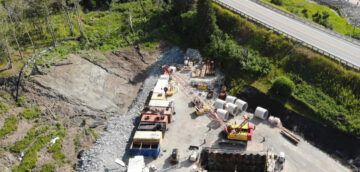McGee Street in Pembroke, Ontario is a 1.1 km residential street that runs next to the Indian River. The sanitary sewer lift station that previously serviced this area was undersized and experienced by-pass sewage conditions during severe wet weather, particularly during the spring melt.
Jp2g Consultants Inc. was engaged by the City of Pembroke in 2017 to remedy this issue. Jp2g provided professional engineering services for the design and contract administration to replace the McGee Street lift station and upgrade the sanitary sewer that feeds to the station.
The project involved the design of a new lift station adjacent to the existing location, including connection to the existing sanitary sewers inlets and new forcemain. The existing diesel generator was relocated from the existing station. A new sanitary sewer was installed along McGee Street from Christie Street to the new lift station, including associated road reconstruction to replace the existing line that ran along the bank of the
Indian River.
Technical scope of the project involved:
Precast Concrete as the Preferred Design Solution: While the structure of the lift station was constructed using cast-in-place methodology, precast concrete was selected for the lift station’s top slab. Precast concrete typically produces a higher-quality product since it’s cured in a controlled environment rather than on the construction site under less-than-ideal conditions. For this application, a precast concrete lid was also easier to install, as compared to cast-in-place due to:
Custom Slabs for Wet Well Chamber: M CON Products partnered with Do-All Construction to build the custom oversized top slab for the lift station. The lid was cast in two sections, with each slab weighing approximately 18,000 kg. M CON Products worked with MSU Mississauga to cast the five (5)
hatches into 4.5 m x 5.0 m slabs. This design option, provided by M CON Products, enabled the contractor to save time and money. It provided versatility to install the internal piping and associated hardware within the
lift station with the top of the structure open, as the precast lids could be installed at any time during the construction sequence. If the lid had been constructed using a cast-in-place method, it would have had to have been installed prior to any internal piping being installed, due to the formwork that would have been required to support this method of construction.
By: Steven Webster, P.Eng., Vice President, Jp2g Consultants Inc.

Harbourside Engineering Consultants (HEC) was retained by Construction Demathieu and Bard (CDB) to develop the ...

The iconic 405-acre Stanley Park borders downtown Vancouver, British Columbia, and sits pristinely on Burrard ...

In recent years, significant rain events have produced an increase in basement flooding issues in ...
